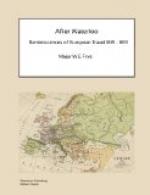The General and myself went to put up at the Tete d’Or, the only inn where we could procure beds; and we embarked early next morning at the embouchure of the canal on board of a treckschuyt which conveyed us in three hours to Bruges.
The landscape between Ostend and Bruges is extremely monotonous, it being a uniformly flat country; yet it is pleasing to the eye at this season of the year from the verdure of the plains, which are all appropriated to pasturage, and from the appearance of the different villages and towns, of which the eye can embrace a considerable number. There is a good road on the banks of the canal, and the troops, on their line of march, enlivened much the scene. Bruges, formerly the grand mart and emporium of the commerce of the East, not only for the Low Countries, but for all the North of Europe, seems, if we may judge from the state of the buildings and the stillness that prevails, to be also in a state of decline. We however had only time to visit the Hotel de Ville and to remark the immense height of the steeple on the Grande Place. We observed a number of pretty women in the streets and in the shops employed in lace making. Bruges has been at all times renowned for the beauty of the female sex, and this brought to my recollection a passage in Schiller’s tragedy of the Maid of Orleans, wherein the Duke of Burgundy says that the greatest boast of Bruges is the beauty of its women.
Another treckschuyt was to start at twelve o’clock for Ghent; but we preferred going by land and General Wilson hired a carriage for that purpose. The distance is about thirty miles. The road from Bruges to Ghent or Gand is perfectly straight, lined with trees and paved like a street. The country is quite flat, and though there is nothing to bound the horizon, the trees on each side of the road intercept the view.
We arrived at Ghent about six in the afternoon of the 4th and had some difficulty in finding room, as the different hotels were filled with officers of the allied army; but at length, after many ineffectual applications at several, we obtained admission at the Hotel de Flandre, where we took possession of a double-bedded room, the only one unoccupied.
Gand seems to be a very neat, clean and handsome city, with an air of magnificence about it. The Grande Place is very striking, and the promenades are aligned with trees. We inspected the exterior of several public buildings and visited the interior of several churches. In the cathedral we had the honour of seeing at High Mass his most Christian Majesty, Monsieur and the Comte de Blacas, Vicomte de Chateaubriand and others, composing the Court of notre Pere de Gand, as Louis XVIII is humorously termed by the French, from his having fixed his head-quarters here. A great many French officers who have followed his fortunes are also here, but they seem principally to belong to the Gardes du Corps. A number of




